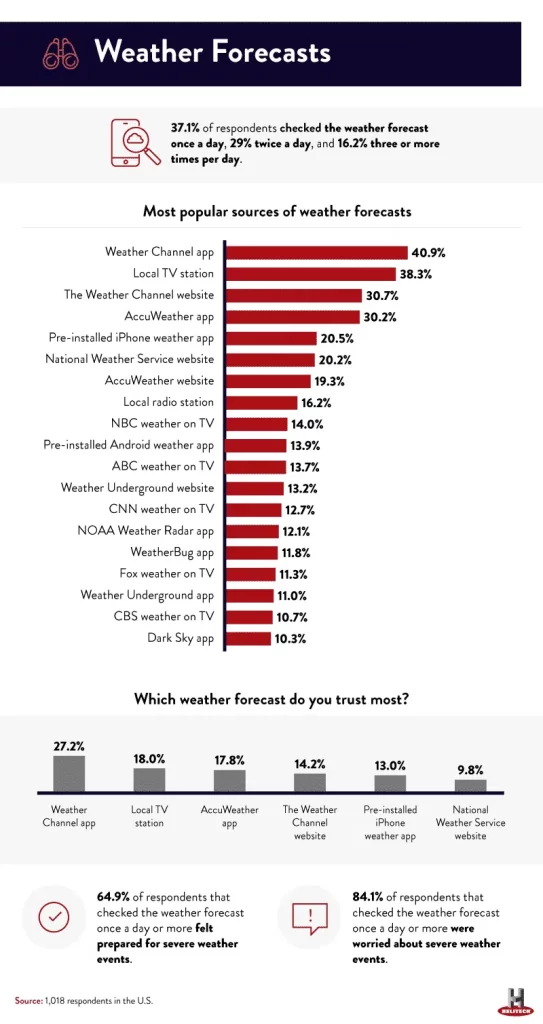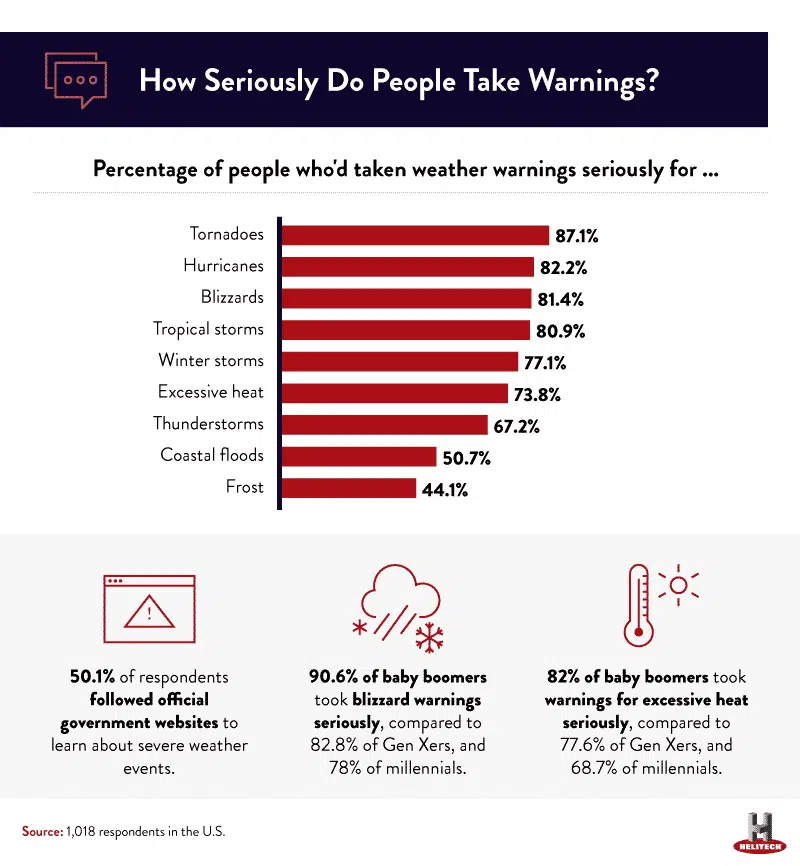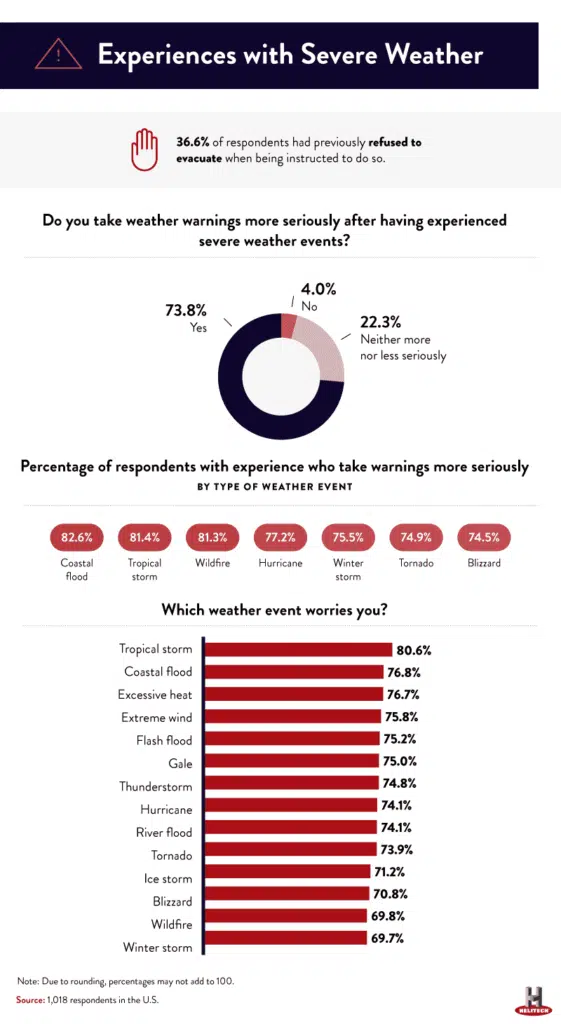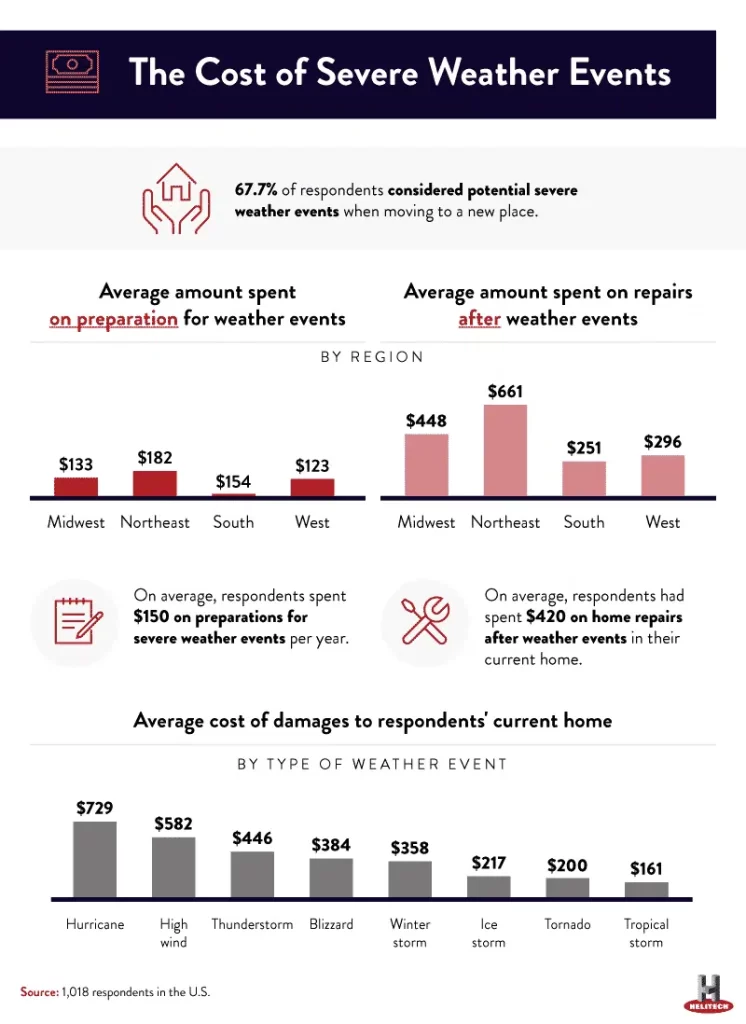
Key Takeaways:
In the middle of February 2021, a historic outbreak of winter weather blanketed most of the country in record-low temperatures, snow, and ice. With roughly half of the U.S. population under some degree of winter weather advisories and over 4 million people without power (a majority located in Texas), this late winter storm quickly turned deadly.
In the hours leading up to the storm, all 254 counties in Texas were under a winter storm warning. But how many people actively heed the severe weather watches and warnings from the National Oceanic and Atmospheric Administration (NOAA) or the alerts from local news outlets?
To find out how seriously Americans take weather warnings, we surveyed over 1,000 people about how much they trust weather forecasts. Read on as we explore how often people are checking the weather; which outlets they trust the most (and least); which warnings they’re most likely to listen to – including those for tornadoes, hurricanes, and blizzards – and which precautions they take ahead of severe temperatures or conditions.

The advent of the internet and our multitude of smart devices mean you no longer have to rely on the local news broadcast or newspaper for the weather forecast. In reality, we’re so tuned into the weather in 2021 that weather service providers sometimes experience bandwidth shortages where there are occasionally too many people accessing data at any given point. Among the more than 1,000 people surveyed, 37.1% of Americans stated they checked the weather forecast once a day, followed by 29% who checked the weather twice daily and 16.2% who checked the forecast three or more times every day.
The ongoing privatization of weather data also means there is no shortage of outlets for retrieving weather data, and they may not also predict exactly the same forecasts. According to people polled, the Weather Channel App (40.9%), local TV stations (38.3%), the Weather Channel website (30.7%), and the AccuWeather app (30.2%) were the most popular places to get weather updates. Despite its popularity, and possibly the confusion caused by its names and branding, the Weather Channel is a privately owned service provider operating for profit and not to be confused with the National Weather Service.
Just 1 in 5 people relied on the National Weather Service for their weather forecast information, and only 9.8% of people said they most trusted the data provided by the National Weather Service. In contrast, the Weather Channel app (27.2%), local TV stations (18%), and AccuWeather app (17.8%) were rated as the most trustworthy.

Perhaps because there are so many different sources for weather updates, or because the weather can’t always be completely accurately predicted, people don’t always trust warnings of severe conditions. Just half (50.1%) of people said they follow official government websites for information on severe weather events.
Just over 87% of people said they take tornado warnings seriously, followed by 82.2% who said the same for hurricanes and 81.4% for blizzards. When looking at it from a generational standpoint, baby boomers (90.6%) took warnings for blizzards much more seriously than Generation Xers (82.8%) or millennials (78%). Overwhelmingly, people were the least likely to take warnings for frost (44.1%), coastal floods (50.7%), and thunderstorms (67.2%) seriously. Lower temperature advisories are often more dangerous than higher temperature conditions, and frost warnings can signal that a freeze is possible, which can create extremely hazardous conditions, particularly on open roads.

Among those surveyed, more than a third (36.6%) said they had previously refused to evacuate after being instructed to do so by local or state governments due to inclement weather. In some cases, people refuse not to evacuate their homes because they can’t afford to relocate, don’t have transportation, or don’t have the means to pay for temporary housing.
Still, personal experience with severe weather can help make people more cognizant of weather warnings in the future. Seventy-four percent of respondents said they took weather warnings more seriously after having their own experiences with severe weather. Just 4% of people said they took weather warnings less seriously after being personally involved in severe weather events. Tropical storms (80.6%), coastal floods (76.8%), excessive heat (76.7%), and extreme wind (75.8%) made people the most worried. In contrast, respondents indicated being the least concerned about winter storms (69.7%), wildfires (69.8%), and blizzards (70.8%). While severe winter weather might make you think of the Midwest or Northeast, the 2021 winter storms were felt from coast to coast by more than 100 million people, including those in Texas, Oklahoma, and New Mexico.

Just 41% of people said they had specific preparations made for a blizzard, including charging their phones (75.2%), buying nonperishable foods (70.9%), and canceling plans and preparing to stay home (67.8%). While slightly fewer people had plans made for a hurricane (32.7%), their actions were roughly the same, to make sure their phones were charged and that they had food stocked up in the event of a power outage. Additionally, 65% of people who said they were prepared for a blizzard said they purchased a first-aid kit. According to the Red Cross, emergency preparations should always include having an emergency preparedness kit on hand, creating a household evacuation plan (including plans for pets), and making sure your family is prepared for the possibility of becoming separated.
Only 12.1% of people reported having a plan in the event of a wildfire, including purchasing a first-aid kit (86.4%), charging their phones in advance (86.4%), and purchasing nonperishable foods (81.8%). Furthermore, 59.1% of those prepared for a wildfire said their plans included packing for a potential evacuation. In addition to closely monitoring the situation through a reliable source (including local news or NOAA radio), the most important part of wildfire safety is being prepared to evacuate on extremely short notice. This means being able to track current fires in your area and knowing where the nearest shelters are.

Severe weather can fluctuate wildly based on where you live. Residents in Southern California might not need to spend as much time preparing for blizzards as they do for wildfires, and people on the opposite side of the country in Florida might be more concerned with hurricanes than earthquakes. It is thus not surprising that 67.7% of respondents said they considered potential severe weather events when moving to a new place.
On average, people surveyed reported spending close to $420 on home repairs after weather events in their current home and $150 on preparations for weather events each year. People in the Northeast spent more money, on average, for both repairs ($661) and preparations ($182) than anywhere else in the country. Still, hurricanes had the potential to be the most destructive, causing $729 worth of damage, on average, followed by high winds ($582), thunderstorms ($446), and blizzards ($384).
Severe weather warnings can be life-saving alerts, tracking anything from tropical storms and hurricanes to tornadoes, wildfires, and blizzards. As we found, most people check the weather multiple times a day, and there’s no clear consensus on which apps or websites are best. Even the ones people used the most often weren’t always the most trusted, and many people acknowledged a lack of preparation for major weather storms or systems to strike.
At Helitech, we know preparing for severe weather also means making sure your home is prepared to sustain the storm. With waterproofing, foundation repair, and concrete leveling, we have over five decades of satisfied customers providing homeowners with long-term solutions for healing their homes against weather damage. With lifetime warranties and American-made products, see the Helitech difference for yourself at HelitechOnline.com today.
Methodology and Limitations
This study uses data from a survey of 1,018 people located in the U.S. Survey respondents were gathered through the Amazon Mechanical Turk survey platform where they were presented with a series of questions, including attention-check and disqualification questions. 46.8% of respondents identified as male, while 53.2% identified as female. Respondents ranged in age from 19 to 79 with an average age of 38. 24.3% of respondents were located in the Midwest, 27.0% in the Northeast, 21.7% in the West, and 27.0% in the South. Participants incorrectly answering any attention-check question had their answers disqualified. This study has a 3% margin of error on a 95% confidence interval.
Please note that survey responses are self-reported and are subject to issues, such as exaggeration, recency bias, and telescoping.
Fair Use Statement
Severe weather can happen when you least expect it and doesn’t always follow a seasonal pattern. We encourage you to share the findings from this survey with your readers for any noncommercial use with a link back to this page so they have access to our full findings and methodology.